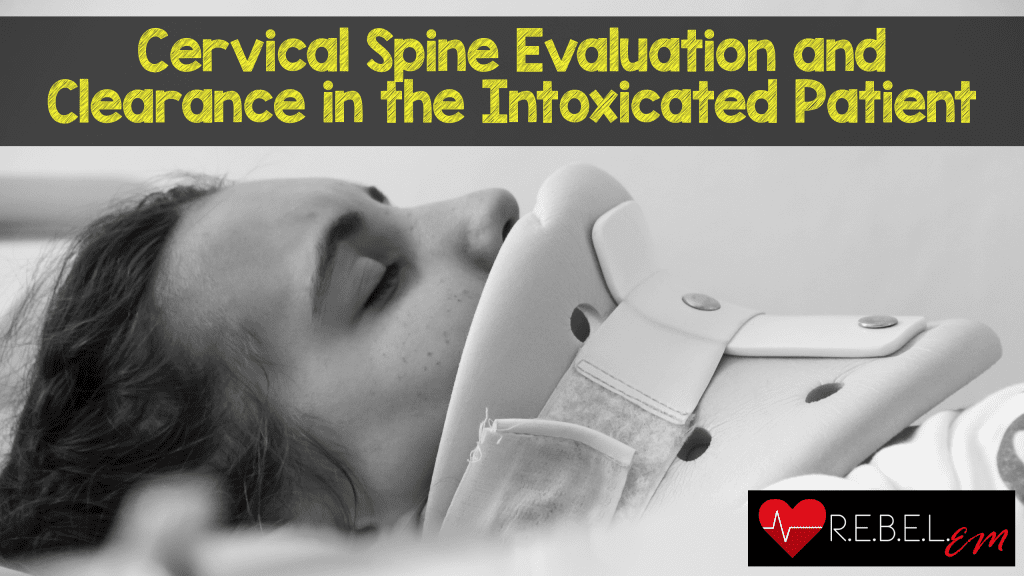 Background: Alcohol and drug intoxication is common in trauma patients and a significant proportion of cervical spine (c-spine) injuries occur in patients with intoxication. A standard approach to both intoxicated and sober patients with suspected c-spine injury in many trauma centers includes the placement of a rigid cervical collar for spinal immobilization until the c-spine can be “cleared.” Even after a negative CT, intoxicated patients often are immobilized for prolonged periods of time until a reliable exam can be performed due to concern for missed findings on CT scan, specifically unstable ligamentous injuries. This practice is less than ideal, as prolonged c-spine immobilization is associated with DVT, atelectasis, aspiration pneumonia, and elevated intracranial pressures. In 2015, the Eastern Association for the Surgery of Trauma (EAST) demonstrated that CT imaging of obtunded patients due to any cause would miss approximately 9% of cervical spine injuries, most of which are clinically insignificant. They additionally found no benefit to prolonged immobilization.
Background: Alcohol and drug intoxication is common in trauma patients and a significant proportion of cervical spine (c-spine) injuries occur in patients with intoxication. A standard approach to both intoxicated and sober patients with suspected c-spine injury in many trauma centers includes the placement of a rigid cervical collar for spinal immobilization until the c-spine can be “cleared.” Even after a negative CT, intoxicated patients often are immobilized for prolonged periods of time until a reliable exam can be performed due to concern for missed findings on CT scan, specifically unstable ligamentous injuries. This practice is less than ideal, as prolonged c-spine immobilization is associated with DVT, atelectasis, aspiration pneumonia, and elevated intracranial pressures. In 2015, the Eastern Association for the Surgery of Trauma (EAST) demonstrated that CT imaging of obtunded patients due to any cause would miss approximately 9% of cervical spine injuries, most of which are clinically insignificant. They additionally found no benefit to prolonged immobilization.
Article: Martin MJ et al. Cervical spine evaluation and clearance in the intoxicated patient: A prospective Western Trauma Association Multi-Institutional Trial and Survey. J Trauma Acute Care Surg 2017;83:1032-40. PMID: 28723840
Clinical Question: What is the accuracy and reliability of CT for identifying clinically significant c-spine injuries in intoxicated patients?
Population: All blunt trauma patients age >17 from 17 level I and II trauma centers in North America that failed local institution-specific protocol for clinical clearance criteria (NEXUS or Canadian C-spine).
Intervention/Exposure: Having a clinically significant cervical spine fracture or injury, defined as requiring surgical stabilization or placement of a stabilizing orthotic brace.
Control: Absence of a clinically significant cervical spine injury fracture or injury.
Outcomes:
- Primary: The performance of cervical spine CT to identify the presence of a clinically significant, c-spine injury in intoxicated patients (serum blood alcohol higher than 80 mg/dL or any positive drug screen test not attributable to an administered medication in the field or ED, or both conditions).
- Secondary: To evaluate cervical spine clearance practices and immobilization times in intoxicated patients; to survey institutional practices and opinions regarding spine clearance in the intoxicated patient.
Design: Nested secondary, prospective multicenter observational trial within the main Western Trauma Association Multicenter C-Spine Trial
Excluded: Patients who had a history of cervical spine instrumentation, patients who were evaluated at an outside facility and then transferred to one of the study centers, and those who did not undergo complete CT imaging of the cervical spine.
Primary Results:
- 10,191 patients enrolled based on inclusion criteria
- 3,005 (30%) of the cohort were classified as intoxicated
- The incidence of cervical spine injury in intoxicated patients ranged from 7.6% (alcohol only) to 10% (alcohol and drugs)
- The incidence of clinically significant cervical spine injury in intoxicated patients ranged from 1.4% (alcohol only) to 2.7% (drugs only)
- All patients were followed until discharge
Critical Findings:

- The single “missed” clinically significant cervical spine injury in the intoxicated patient cohort included a patient who developed central cord syndrome without a bony fracture or ligamentous injury
- Duration of immobilization (mean time)
- Intoxicated 8 hours vs. non-intoxicated 2 hours (p < 0.01)
- 25% of intoxicated patients kept in immobilization for >12 hours
- Among patients admitted for continued c-spine immobilization, the presence of intoxication was the sole reason for keeping them in a cervical collar in 42%
Strengths:
- Asked a simple, clinically relevant question with a patient-centered outcome
- This was a large, prospectively collected study sample enrolled from multiple study sites increasing external validity
- Minimal exclusions making the study more generalizable
- All patients were followed until final disposition
- The majority of patients were unevaluable on exam due to intoxication, leading to a reliance on CT imaging as a sole modality for identifying cervical spine injury
Limitations:
- There was no gold standard assessment for patients
- All patients did not get MRI to confirm the absence of significant injuries
- Absence of injuries was based on repeat clinical evaluation
- No long term follow up was performed
- This is always difficult in at risk populations like patients with intoxication related issues
- Patients may have had delayed presentations that would not have been known as there was no formal follow up evaluation
- Routine testing for serum ethanol and urine toxicology were not mandated and the study did not disclose what percentage of patients were tested
- Urine toxicology is not a reliable indicator of acute intoxication
- Many patients suspected of intoxication in the ED do not receive serum alcohol testing or urine toxicology, leading to questions of generalizability of the study results
- There was no standardized protocol for applying and clearing cervical spine immobilization
- In the intoxicated patient cohort, the predominant mechanism of trauma was vehicular, which presents questions of generalizability when applying results to an urban population
- The study did not fully describe the subset of patients with false negative CT scan for cervical spine injury (the number of patients in this cohort, type of injury, how it was diagnosed, etc.)
Author’s Conclusions:
“For intoxicated patients undergoing [cervical spine] imaging, CT scan was highly accurate and reliable for identifying clinically significant spine injuries. CT-based clearance in intoxicated patients appears safe and may avoid unnecessary prolonged immobilization.”
Our Conclusions:
For intoxicated patients with a negative cervical spine CT, there appears to be little benefit to maintaining prolonged immobilization unless there is an obvious neurological deficit or high degree of suspicion for cord injury. This is consistent with previous literature in CT performance in obtunded patients.
Potential Impact on Current Practice:
Many ED’s do not have specific guidelines addressing clearance of the c-spine after negative CT imaging. Due to the rare occurrence of an unstable cervical spine injury in intoxicated patients with a negative c-spine CT, it is reasonable to remove spinal immobilization in patients with a non-focal neurologic exam. Repeat neurologic evaluation prior to discharge should be performed to ensure that significant injuries aren’t missed.
Clinical Bottom Line:
For intoxicated patients with a negative cervical spine CT and a non-focal neurologic evaluation, there appears to be little benefit to maintaining prolonged immobilization. Patients should have their neuro examination reassessed when clinically sober.
Guest Post By:

References:
- Inaba K, Byerly S, Bush LD, et al. Cervical spinal clearance: A prospective Western Trauma Association Multi-institutional Trial. J Trauma Acute Care Surg 2016;81:1122-30.
- Patel MB, Humble SS, Cullinane DC, et al. Cervical spine collar clearance in the obtunded adult blunt trauma patient: a systematic review and practice management guideline from the Eastern Association for the Surgery of Trauma. J Trauma Acute Care Surg 2015;78:430-41
Post Peer Reviewed By: Anand Swaminathan, MD (Twitter: @EMSwami) and Salim R. Rezaie, MD (Twitter: @srrezaie)



